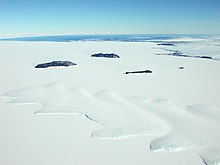Erebus Glacier Tongue
It projects 11 kilometres (6.8 mi) into McMurdo Sound from the Ross Island coastline near Cape Evans, Antarctica.
Hut Point Peninsula to the south helps deflect icebergs propelled by prevailing southerly winds.
The Erebus Glacier Tongue is a dynamic structure subject to a host of internal and external stresses which affect its shape, size, and durability.
[6] Contemporary cave explorers who squeezed through a narrow tunnel several hundred feet long to emerge into a large cavern describe their Erebus Glacier Tongue experience as: Sitting quietly we absorb the natural beauty.
Breaking off pieces of ice, 10 or 20,000 years old, we melt it in our mouths and savour the taste of pure, uncontaminated water.
[7] Scientists funded by a National Science Foundation grant have retrieved rare underwater views of the Erebus Glacier Tongue caves by mounting cameras on Weddell seals.
Adelie are particularly noted for their rookeries on Erebus Bay's rocky north shore at nearby Cape Royds.
Scarce mention of the glacier tongue's surface, which is more than a mile wide,[11] is made in popular literature.
Indeed, British researchers in 2006 discovered a correlation between lunar tides (caused by gravitational pull) and variances in flow speed of the Rutland Ice Stream in Antarctica.
[4] Moreover, the river of ice carries with it weaknesses introduced by earlier fractures experienced during its journey down the slopes of Mount Erebus.
[18] The forces of wave action from McMurdo Sound, tides, and internal stresses exploit the glacier tongue's weaknesses.
Subsequently, small icebergs and bergy bits typically calf from the Erebus Glacier Tongue but only when the sea ice has broken up.
Subsequently, iceberg calving is seasonal and periodic, as open water is needed to release the bergs into Erebus Bay.
[19] Members of Robert F. Scott's Terra Nova Expedition first observed the glacier tongue calving in March 1911 when a 4 km section broke off during a gale.
[1] A similar event in March 1990 produced a 100-million ton iceberg, 3.5 km long, from the glacier tongue.



